Phoenix << FEE nihks >> is the capital and largest city of Arizona. It is also a manufacturing center and a major winter-resort area. Phoenix lies in the Salt River Valley, a flat region ringed by low mountains.
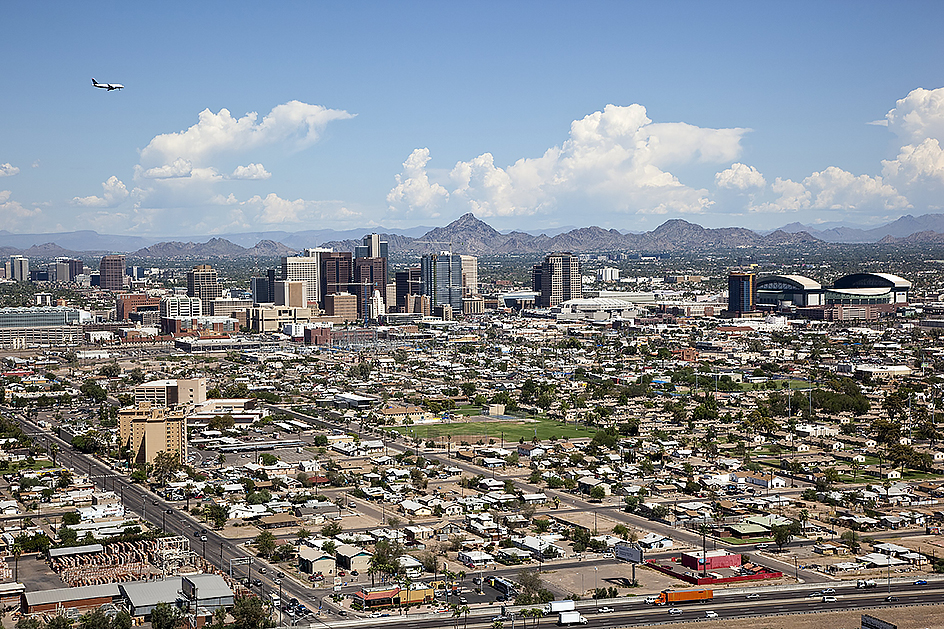
The city has a warm, sunny, dry climate. Winter temperatures range from about 45 to 70 °F (7 to 21 °C), while summer temperatures regularly exceed 100 °F (38 °C). The sun shines about 325 days a year. Early resorts in Arizona once offered visitors free rooms and meals on days the sun did not shine.
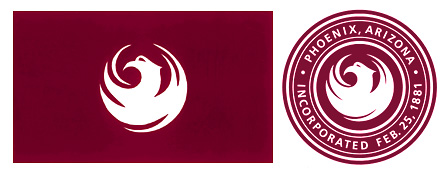
White pioneers first settled the Phoenix area in the 1860’s. One of them, Jack Swilling, noted the ruins of Indigenous (native) Hohokam settlements there. Darrel Duppa, another settler, proposed naming the settlement Phoenix for the mythical bird that rose from its own ashes every 500 years. Starting in the mid-1900’s, Phoenix became one of the fastest-growing cities in the United States. In 1950, it ranked 99th in population among the nation’s cities. By 2020, Phoenix had become the nation’s fifth largest city. Aerospace and electronics manufacturing, air travel, and the climate—moderated by the widespread use of air conditioning—helped bring about the rapid growth.
The city
Phoenix and its neighboring communities lie in the broad, flat Salt River Valley, which is surrounded by mountains. East of Phoenix, the Salt River is joined by the Verde River from the north and runs westward through the valley. Dams on these rivers, and on the Agua Fria River to the west, create a series of lakes and provide hydroelectric power. The water is sent through canals and pipes for agricultural and urban uses. The riverbeds are usually dry in the Phoenix area. Since 1986, Phoenix has received water from the Colorado River on Arizona’s western border through aqueducts of the Central Arizona Project.
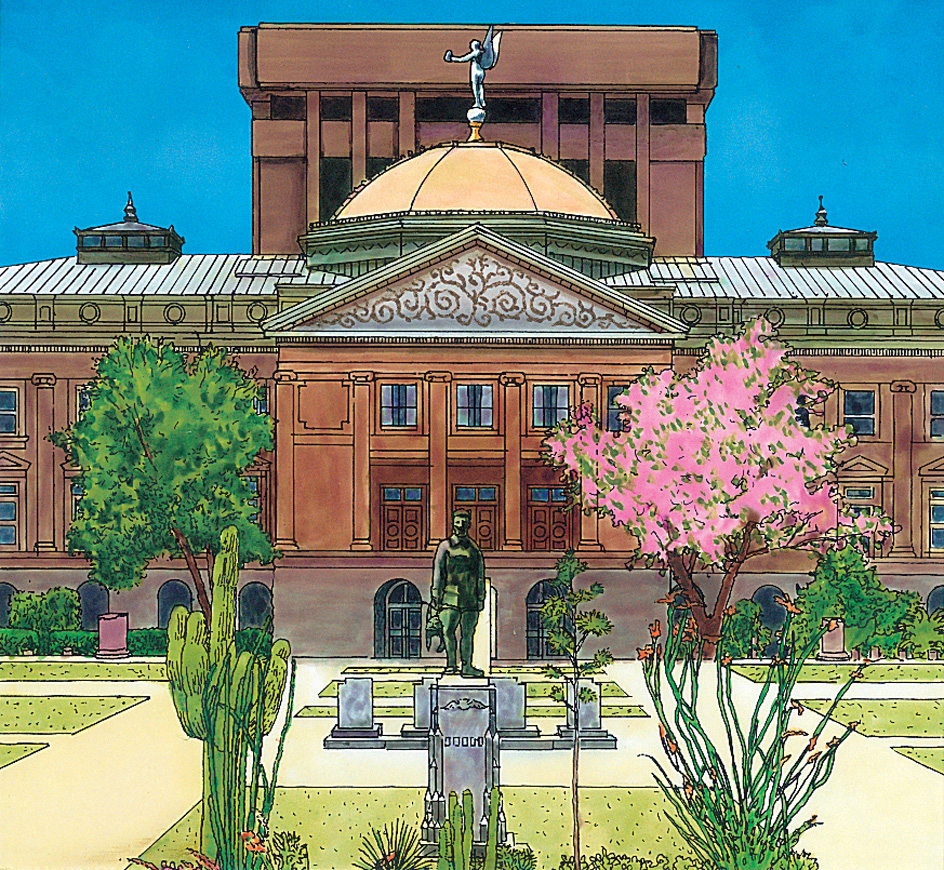
Layout of Phoenix.
Phoenix is the seat of Maricopa County. Phoenix began as a trading center for a farming district that grew to more than 500,000 acres (200,000 hectares) of irrigated land. Urban growth has eaten up roughly half of the area’s farmland.
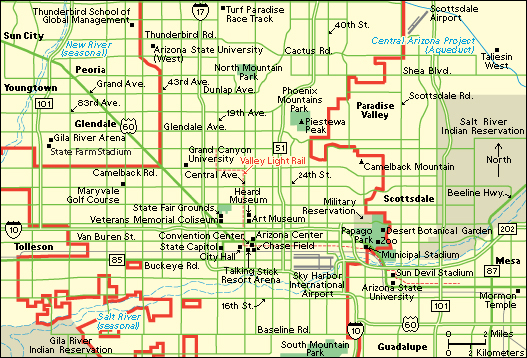
Downtown Phoenix hosts the city’s financial district, as well as various municipal, county, state, and federal government buildings. The downtown area includes a convention center, a basketball arena, a baseball stadium, Symphony Hall, and various theaters and museums. After 2000, the city began developing a cluster of biomedical business and research facilities. These facilities included the Translational Genomics Research Institute and new campuses for the University of Arizona College of Medicine and Arizona State University. The Arizona Center is a complex of offices and shops. Housing construction has created new residential opportunities downtown.
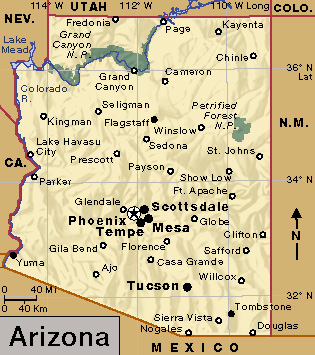
Residential areas, with their shopping malls, extend far beyond the downtown area. A few buttes (steep hills) pop up in the middle of the urban area. For example, Camelback Mountain rises 2,704 feet (824 meters) in an expensive residential area in eastern Phoenix. Piestewa Peak, which rises 2,608 feet (795 meters) in the northern part of the city, is popular for hiking.
The metropolitan area
of Phoenix includes all of Maricopa and Pinal counties. The U.S. Census Bureau classifies this area as the Phoenix-Mesa-Chandler metropolitan statistical area.
Several large communities lie in the Phoenix area. Mesa, the largest, had over 500,000 people at the 2020 census. Others include Chandler, Gilbert, Glendale, Scottsdale, and Tempe. The area’s rapid pace of development has linked many separate communities into a continuous suburban sprawl.
People
The residents of Phoenix are called Phoenicians. The city’s climate has drawn many residents from other parts of the United States. Most Phoenicians were born outside the Phoenix area.
Ethnic groups.
Non-Hispanic white people account for over 40 percent of the city’s population. About 40 percent of the city’s people are Hispanic. Hispanic people have made up a growing share of Phoenix since the late 1900’s. African Americans account for 8 percent of the population, while Asians make up 4 percent and Native Americans 3 percent.
Housing.
Phoenix is largely a city of single-family homes. Following World War II (1939-1945), newcomers began flocking to Phoenix. Phoenix contractors bought up farmland and built sprawling subdivisions of single-family homes. Using mass-production techniques, John Long and other developers built neighborhoods, such as the Maryvale district of west Phoenix, with modest and affordable houses. More expensive housing tended to be concentrated in northeast Phoenix and in adjoining Scottsdale. The largest Hispanic and African American neighborhoods are in southern Phoenix.
Since the 1960’s, separate retirement communities have added a new element to the population and housing patterns of the Phoenix area. Such large developments were built especially for retirees. The largest ones are Sun City and Sun City West, northwest of Phoenix, and in the Mesa and Chandler regions in the southeast.
Education.
Maricopa County has more than 50 public school districts. More than 30 of these districts are in the city of Phoenix. The city and county also have numerous charter, private, and parochial schools. The county runs one of the nation’s largest systems of two-year community colleges. Arizona State University operates several campuses in the Salt River Valley. Its Tempe campus has one of the largest enrollments of any campus in the nation. Another institution of higher education, the School of Architecture, operates at two sites, Cosanti in Paradise Valley and Arcosanti in Yavapai County, north of Phoenix.
Growth problems.
Growth has increased traffic congestion and air pollution, much of which results from automobile exhaust. Common weather conditions often serve to trap polluted air in the desert valley. A “heat island” effect has become an increasingly serious problem, as the spread of buildings and pavement have driven up the summer nighttime temperatures. The issue most basic to the area’s continued growth is its water supply.
Cultural life
The arts.
Phoenix is the home of the Phoenix Symphony, Ballet Arizona, and many smaller organizations. The Arizona Theatre Company performs part of each season in Phoenix and part in Tucson. The major theaters in Phoenix include the Herberger Theater Center, the Orpheum Theatre, and Symphony Hall. Arizona State University in Tempe is home to Grady Gammage Memorial Auditorium, also called ASU Gammage, a historic performing arts center. Completed in 1964, it was the last major public building designed by architect Frank Lloyd Wright. Scottsdale, Mesa, and Chandler have major performing arts facilities.
Museums and libraries.
The Heard Museum focuses on Southwestern Native American culture. The Phoenix Art Museum features European and Asian art and contemporary art of the U.S. Southwest. The Arizona Historical Society Museum chronicles the settlement and growth of Phoenix. Downtown also hosts the Arizona Science Center. The Phoenix Public Library and the Maricopa County Library District maintain many branches in the area.
Recreation.
Many Phoenix residents enjoy outdoor life, which the mild climate favors. Popular activities include trips to nearby mountains and boating on lakes built to store irrigation water. The metropolitan area has many golf courses.

The Phoenix Zoo is in Papago Park, an area of stone buttes on the Phoenix-Tempe border. The Desert Botanical Garden, also in the park, features plants native to deserts throughout the world. South Mountain Park, one of a number of mountain park reserves in Phoenix, is the largest municipal park in the United States. It covers more than 16,000 acres (6,470 hectares).
The Phoenix area hosts several professional sports teams. The Phoenix Suns of the National Basketball Association and the Arizona Diamondbacks of baseball’s National League play their home games in the downtown area. Glendale hosts the Arizona Cardinals of the National Football League. Phoenix International Raceway, in Avondale, features automobile races. Turf Paradise, in northern Phoenix, hosts a winter season of horse races.
Major annual events include college football’s Fiesta Bowl and the Waste Management Phoenix Open golf tournament. The yearly Arizona National Livestock Show recalls the area’s Western heritage.
Economy
Service industries, particularly tourism and government activities, play a key role in the economy of the Phoenix area. Construction and manufacturing also contribute heavily to the economy.
Service industries.
Tourists flock to the many vacation resorts, golf courses, and other attractions in the Phoenix area. Although strongest in winter, tourism is a year-round industry that generates much income and employment. State, county, and city governments operate in Phoenix and provide many jobs. Luke Air Force Base, near Glendale, also contributes to the economy.
Manufacturing.
The Phoenix area’s chief manufactured products include aircraft, aircraft engines and parts, computers, guidance and navigation equipment, and semiconductors. The area’s products also include agricultural chemicals, air-conditioning equipment, and cosmetics.
Transportation and communication.
Phoenix Sky Harbor International Airport ranks among the nation’s busiest airports. Passenger and freight railroad lines and numerous trucking companies serve the city. A light-rail system serves Phoenix, Tempe, and Mesa. Phoenix has one daily newspaper, The Arizona Republic.
Government
Phoenix has a council-manager form of government. The voters elect a mayor and eight City Council members, who are chosen from districts. Both the mayor and the council members serve four-year terms. The council hires a city manager to carry out its policies, prepare the city budget, and appoint and dismiss department heads.
History
Settlement.
The Hohokam people lived in the Salt River Valley from about 300 B.C. until the 1400’s. They constructed a system of canals to take water from the Salt and Gila rivers to irrigate their crops. In 1539, Spanish explorers became the first white people to reach the area. The area belonged to Spain from 1539 until 1821, when it became part of Mexico. It became part of the United States in 1848, when the United States defeated Mexico in the Mexican War. The Phoenix area was part of the New Mexico Territory from 1850 until 1863, when the U.S. government created the separate Territory of Arizona.
In 1865, the U.S. Army established Camp McDowell northeast of the future site of Phoenix to protect settlers and miners in central Arizona. Farmer John Y. T. Smith contracted to provide food for the Army post. He hired adventurer Jack Swilling to cut hay growing wild along the Salt River. Swilling recognized ancient Hohokam irrigation canals on the valley floor and hired a party of men to dig them out again. They built dams across the river to redirect water into the canals. In 1870, settlers selected and surveyed the official town site, in what is now the downtown area, marking the founding of Phoenix. Phoenix was incorporated as a city in 1881.
Early developments.
Because of the mild winters, fertile soil, and abundant water, agriculture prospered and Phoenix grew. More canals were dug, bringing more land under cultivation, and prompting the settlement of additional towns. Branch railroads connected Phoenix to the Southern Pacific (now Union Pacific) Railroad’s main line in 1887 and to the Santa Fe’s main line (now part of Burlington Northern Santa Fe Corporation) in 1895. This enabled the city to become a center for trading and processing farm products, and a retail center for the Salt River Valley.
The Salt River’s irregular flow caused problems. At times, it was nearly dry; but at other times it flooded and carried away farms and houses. In 1903, valley residents won support from the U.S. Reclamation Bureau to build Theodore Roosevelt Dam 55 miles (86 kilometers) northeast of Phoenix to store water for irrigation, control the Salt’s flooding, and produce hydroelectric power. The dam began operations in 1911, and the amount of land under agricultural production grew considerably.
Phoenix was named the capital of the Territory of Arizona in 1889. Arizona became a state in 1912, and Phoenix remained the capital. By 1920, Phoenix had a population of 29,053, making it Arizona’s largest city.
In the late 1800’s, visitors were drawn to Phoenix by claims that its healthy climate would aid people suffering from respiratory problems. Tourism became more important in the 1920’s. During the Depression of the 1930’s, boosters promoted tourism as an economic strategy. Efforts to attract wealthy tourists included construction of various resorts and support for the city’s small-yet-growing airport. Phoenix grew steadily but modestly until 1940, when the population reached 65,414.
Dramatic growth.
During World War II (1939-1945), the U.S. military built two air bases and four air training fields near Phoenix. It also built several Army camps for desert warfare training. The federal government also constructed three factories for manufacturing aircraft parts, employing 15,000 workers. After the war ended in 1945, business and government leaders worked to attract aerospace and electronics manufacturers to the area.
The workers drawn to the area included many military veterans who had trained in Arizona and liked it. Two methods of climate control encouraged new settlement by making the hot summers more tolerable. “Evaporative coolers,” which blow moist air into homes, became available after the mid-1930’s. Development of affordable air conditioning during the 1950’s provided even greater comfort. Large numbers of retired people began moving to the area after 1960. The economic and population growth in Phoenix was part of a national trend in growth in the so-called Sun Belt, areas with warm climates.
Phoenix steadily annexed surrounding areas to allow for continued growth. In 1950, the city covered only 17 square miles (44 square kilometers). Its size has since increased to over 500 square miles (1,295 square kilometers). Annexations also resulted in population growth.
The population of Phoenix totaled 106,818 in 1950. Then, in just 10 years, the population quadrupled—soaring to 439,170 in 1960. In 1950, Phoenix had ranked as the 99th largest U.S. city in population. By 1980, with 789,704 people, the city ranked 9th.
Water has been the defining aspect of life in Phoenix. In 1968, the U.S. Congress authorized funds to build the Central Arizona Project. This project was designed to bring water from the Colorado River along Arizona’s western border to Phoenix and southern Arizona.
In the 1950’s and 1960’s, downtown Phoenix lost many of its businesses when companies moved to new suburban shopping malls. However, since about 1990, the city has redeveloped much of its downtown area, constructing numerous government and private office buildings, sports facilities, museums, and other cultural attractions.
The 2000’s.
Drawn by climate, economic opportunity, and relatively affordable housing, newcomers poured into the Phoenix area. By 2020, the city’s population reached 1,608,139, and Phoenix was the hub of a metropolitan area of nearly 5 million people. In 2008, a light-rail transportation system began service linking Phoenix, Mesa, and Tempe.
